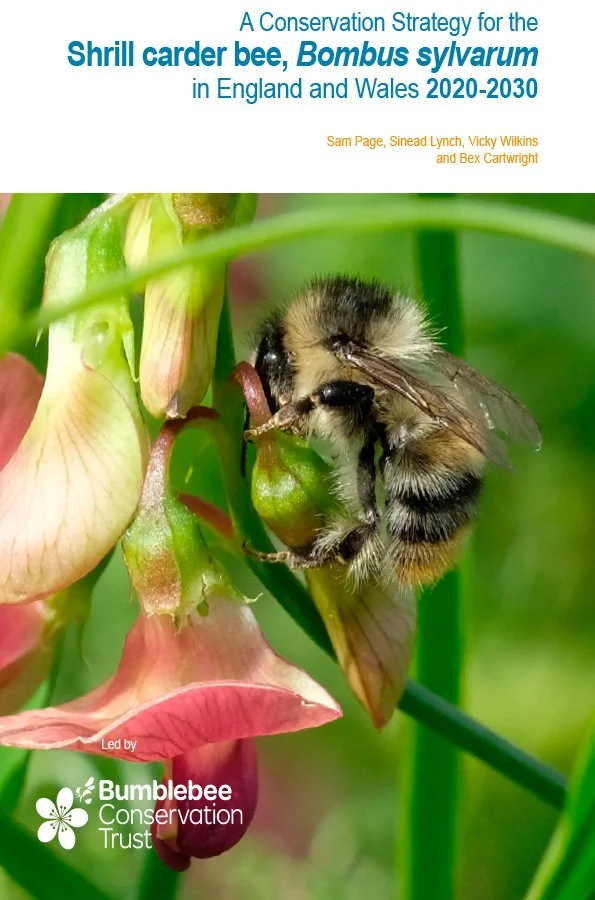Shrill carder bee
Shrill carder bee (C Harris)
In July 2020, the Bumblebee Conservation Trust (BBCT) with partners launched the Shrill Carder Bee Conservation Strategy 2020-2030 (Page, et al 2020). Much of the information for this section is taken from this strategy.
Once fairly widespread, this extremely rare bee is found in only 2 populations in England and 3 in Wales. One of these populations is on the Gwent Levels.
The shrill carder bee (SCB) is a late emerging bumblebee, with queens emerging from hibernation to establish new colonies in May. The best time to see this bee is July to September when the workers can be seen. The SCB is distinctive with its pale grey-yellow colouring, a black band of hair between the wings and reddish-orange tail.
This bee requires landscape-scale conservation efforts and is a flagship species for the restoration of a network of connected flower-rich habitats, which benefit pollinator species, and brings other biodiversity and landscape benefits.
Within the Gwent Levels the species is associated with flower-rich reen, ditch and field margins as well as road verges and the vegetated sea wall, where there are abundant sources of pollen and nectar.
Good quality SCB sites occur where these forage sources are in close proximity to undisturbed tall tussocky grassland for nesting. Management for this species focuses on ensuring plentiful flower-rich habitat, (with species such as white dead-nettle, red bartsia, meadow vetchling, knapweeds, thistles, sea aster, scabious and red clover), especially from late summer into early autumn to allow them to produce the next generation of males and new queens.
Key management
Maintaining, creating and linking flower-rich grassland
Connecting open flower-rich grasslands with each other across the Levels, is beneficial to many species not least SCB. Isolated SCB sites makes them vulnerable to being lost, whereas increasing and linking suitable habitats makes them more resilient. This could be flower rich buffer strips along field margins, road verges, in gardens, school grounds and alongside reens and ditches. The sea wall managed in a way to promote a flower rich sward would be an important link for existing habitats throughout the Levels. NRW is piloting a new cut and collect regime to improve sward diversity along sections of the Sea Wall.
Saltmarsh grazing
Saltmarsh supports important late season forage plants such as sea aster. Therefore, a grazing level which doesn’t suppress these plants is vital.
Grass Cutting
As a late-emerging species with colonies that persist into early autumn, the SCB nest cycle often coincides with operations such as hay-cutting, hedge trimming and road verge management all of which reduce the areas of suitable forage.
When cutting in July to September cannot be avoided some patches and margins with flowering plants should be left uncut.
Taking an earlier cut in June-July can extend the flowering period by encouraging re-growth and flowering later in the year, particularly in legume-rich habitats.
Rotational cutting regimes can work well, with some areas cut earlier in June -July and others cut later in September-October. The order of cutting could be rotated each year.
Nesting Habitat (tussocky grass)
Once an area has been identified as nesting habitat for SCB, a 2- or 3-year cycle of mowing or grazing can be used to keep an open, tussocky sward. Timing of any management is critical as care needs to be taken to avoid disturbance of the bees when nesting.
Pesticides, and other inputs
The use of pesticides and fertiliser decreases the diversity of the sward, and insecticides would obviously be detrimental to the bee and other insects. Their sites are also susceptible to spray drift. Raising awareness of where SCB populations are would enable them to be avoided by direct or indirect applications. The Levels are in the main covered by 8 SSSIs, within these areas most applications of agricultural inputs need to be consented by NRW.
More information
Further advice can be found on the BBCT website bumblebeeconservation.org and if you think you have SCB on your land please contact BBCT at enquiries@bumblebeeconservation.org.
Shrill carder bee (male) (R Bacon)

